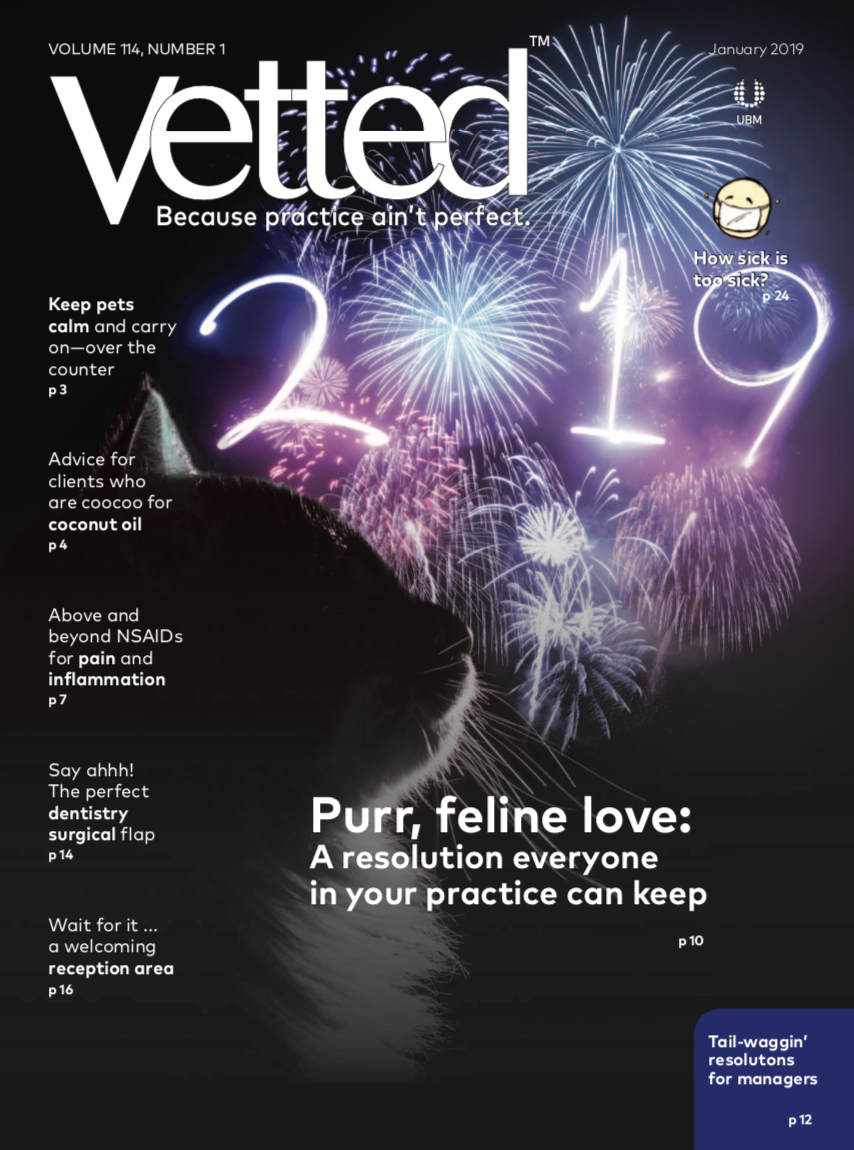Going above and beyond NSAIDs to banish pain and inflammation
The linkages among inflammation, obesity, osteoarthritis and chronic maladaptive pain call for a multimodal rethinking of the best way to help our veterinary patientsincluding taking their fat compartments into consideration.
Eric Isselee - stock.adobe.com Divinum est opus sedare dolorem: Divine is the work to subdue pain. - Galen

Pets have made a migration of biblical proportion from the backyard to the bedroom and from the kennel to the kitchen to the couch. Most pet owners now self-identify as “pet parents,” and in one survey from Pfizer Animal Health in 1997, many respondents were willing to state that the family dog was a better companion than the other humans in the family. If this trend continues, veterinarians and their healthcare teams will always have a job to do!
Veterinarians are the only physicians who take care of their patients from womb to tomb, and as a result of the amazing advances in veterinary medicine in recent decades, our patients are living longer and better than ever before. While old age is not a disease, there are important medical issues that are associated with aging. For instance, we know that approximately 20% of cats and dogs across all ages suffer from the inflammation and pain of osteoarthritis (OA).1,2 We also know that the incidence of OA increases with age. Among cats 10 years of age and older, more than 90% are likely to have OA in at least one joint.2 The sheer number of these patients demands our attention.
Knowing that one of OA's pain-generating elements is inflammation, decreasing inflammation becomes a critical aspect of managing OA and maximizing patient comfort. Moreover, once pain is present, systemic inflammation (inflammation beyond the OA-affected point) can enhance and amplify the pain experience, regardless of where the pain originates.
We know that all pain is complex, subjective, easy to overlook (especially in nonverbal species) and challenging, as managing it means changing how we do things (and we humans aren't always quick to embrace change!). But despite our reluctance to try new things, it's useful to remember that unmanaged (or undermanaged) pain leads us down a dark rabbit hole in which pain moves from a minor nuisance, to decreased quality of life, to unbearable suffering, and it can ultimately result in physical pathology that leads to death. In other words, it's not an exaggeration to state that pain kills.
A multimodal mandate
Managing pain that no longer serves a useful physiologic protective purpose means thinking beyond the pharmacological tool we typically reach for first: nonsteroidal anti-inflammatory drugs (NSAIDs). To manage inflammation and its associated pain from a multimodal perspective means we must recognize all the ways inflammation can arise and how we can target it.
Most chronic patients are less active because they're not comfortable moving as they once did. Consequently, they're often overweight or obese. The white fat that accumulates in overweight and obese patients secretes inflammatory and proinflammatory hormones that can enhance and amplify the chronic pain experience. For this reason, normalizing body composition-decreasing both the pet's weight and the size of its fat compartment-is a critical component of any multimodal pain management strategy.
Normalizing body composition goes beyond simple calorie restriction. Calorie restriction alone will shrink the body mass but will proportionately keep the fat compartment (in other words, a large marshmallow will simply become a smaller marshmallow). It's important to use a nutrient profile proven to allow the pet's body to burn fat selectively for its energy. Reducing the body's fat compartment can make a positive impact on reducing overall inflammation, and that in turn can help reduce the pet's OA pain.
There are two other nutritional strategies to reduce inflammation and pain: omega-3 fatty acids (specifically eicosapentaenoic acid, or EPA, and microlactin (the active ingredient in PRN Pharmacal's Duralactin products). The omega-3 should be in the triglyceride form for optimal absorption and utilization, and generally, the daily total should be divided into two doses-one in the morning, and one at night.
Microlactin is a protein extracted from the milk of hyperimmunized cows that has been demonstrated to reduce systemic inflammation in multiple species, regardless of etiology. Microlactin uses a different pathway in the body than corticosteroids and NSAIDs, which means it can be given alongside either of these. It takes 10 to 14 days for microlactin to reach peak effects, and at that point, it may be reasonable to begin reducing the dose of the NSAID or steroid.
Because inflammation can have a detrimental effect on many body systems and tissues, the benefits of reducing systemic inflammation can reach beyond reducing the inflammatory pain of joint OA. The strong linkages among inflammation, obesity, OA and chronic maladaptive pain point to a need to decrease the patient's fat compartment (by reversing overweight and obesity) to reduce both systemic and joint inflammation. Reducing pain and inflammation will in turn allow the pet to be more active, further contributing to reduced inflammation, better health and improved and sustained quality of life.
References
- Bland S. Canine osteoarthritis and treatments: a review. Vet Sci Development 2015;5(2):84-89.
- Kerwin, SC. Osteoarthritis in cats. Top Companion Anim Med 2010;25(4):218-223
Dr. Robin Downing, who holds a master's degree in clinical bioethics, is a diplomate of the Academy of Integrative Pain Management, a diplomate of the American College of Veterinary Sports Medicine and Rehabilitation, a certified veterinary pain practitioner, a certified canine rehabilitation practitioner, and hospital director at the Downing Center for Animal Pain Management in Windsor, Colorado.
